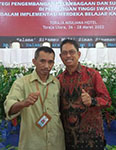Akuatikisle: Jurnal Akuakultur, Pesisir dan Pulau-Pulau Kecil
Full Length Article
Identification of sea grape (Caulerpa racemosa) content using X-Ray Fluorescence (XRF) spectrometer
Highlights
Generate NLP AI by Wizdam ID.
Abstract
Seaweed possesses the potential to serve as a functional food or supplement, being nutrient-dense and a source of food and medicine due to its abundance of minerals, vitamins, and antioxidants. In Indonesia, seaweed is extensively utilized due to its advantageous properties for multiple industries, including agriculture, animal husbandry, pharmaceuticals, chemicals, and medicine. This study seeks to discover a specific component of sea grape (Caulerpa racemosa), which is prevalent in the waters of Lohia Village, Lohia District, Muna Regency, Southeast Sulawesi. The composition of sea grape (Caulerpa racemosa) was analyzed utilizing an X-ray Fluorescence Spectrometer (XRF) due to its capacity to detect nearly all minerals in a single measurement. The study's findings indicated that sea grapes (Caulerpa racemosa) at stations 1, 2, and 3 contained Chlorine (Cl), Calcium (Ca), Potassium (K), and Bromine (Br), along with several trace elements including Iron (Fe), Phosphorus (P), Strontium (Sr), Silicon (Si), and Titanium (Ti) in minor quantities. At stations 4, 5, and 6, sea grapes (Caulerpa racemosa) predominantly exhibited Chlorine (Cl), Potassium (K), and Magnesium (Mg), whereas Calcium (Ca) and Bromine (Br) were present in lesser quantities. Despite the considerable benefits of sea grapes (Caulerpa racemosa) for humans, caution is imperative in their use. Sea grapes (Caulerpa racemosa) possess the capacity to absorb minerals and bioaccumulate heavy metals from seawater, resulting in the presence of trace elements.
Keywords
Introduction
Section snippets
Material and Methods
Materials and methods from the full-text PDF of this article cannot be displayed.
Results
Results from the full-text PDF of this article cannot be displayed.
Discussion
Discussion from the full-text PDF of this article cannot be displayed.
Conclusions
Conclusions from the full-text PDF of this article cannot be displayed.
Acknowledgment
Acknowledgment from the full-text PDF of this article cannot be displayed.
Competing interest
The authors declare that they have no known competing financial interests or personal relationships that could have appeared to influence the work reported in this paper.
Conflict of interest
The authors declare that the research was conducted in the absence of any commercial or financial relationships that could be construed as a potential conflict of interest.
Ethical approval acknowledgements
No ethical approval required for this article. All procedures followed were in accordance with the ethical standards of the responsible committee on human experimentation (institutional and national) and with the Helsinki Declaration of 1975, as revised in 2008 (5)
Supplementary files
Data sharing not applicable to this article as no datasets were generated or analysed during the current study, and/or contains supplementary material, which is available to authorized users.
Bibliographic Information
Cite this article as:
-
Submitted
27 March 2025 -
Accepted
25 July 2025 -
Published
28 July 2025 -
Version of record
9 September 2025 -
Issue date
30 November 2025
-
Academic subject
Aquaculture; Fisheries Sciences
Copyright
Copyright © 2025 Dewi Susilawati, Fendi, Rochmady, Abdul Rakhfid, Mosriula. Sangia Research Media and Publishing. Production and hosting by Sangia (SRM™).  This work is licensed under a Creative Commons Attribution-ShareAlike 4.0 International License.
This work is licensed under a Creative Commons Attribution-ShareAlike 4.0 International License.
Disclaimer: All claims expressed in this article are solely those of the authors and do not necessarily represent those of their affiliated organizations, or those of the publisher, the editors and the reviewers. Any product that may be evaluated in this article or claim that may be made by its manufacturer is not guaranteed or endorsed by the publisher.
Comments on this article
By submitting a comment you agree to abide by our Terms and Community Guidelines. If you find something abusive or that does not comply with our terms or guidelines please flag it as inappropriate.




